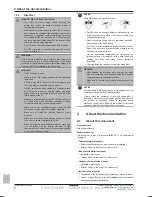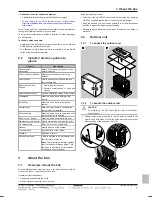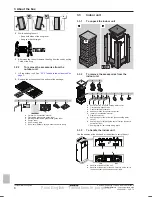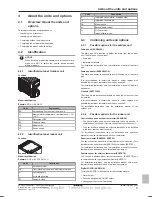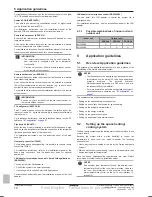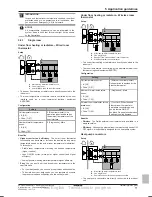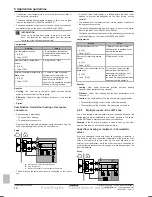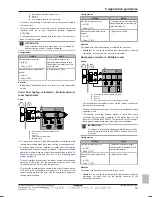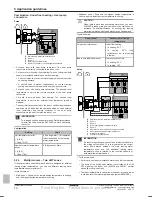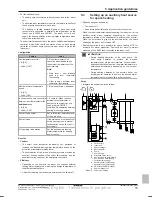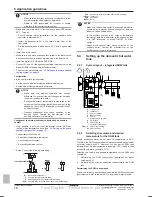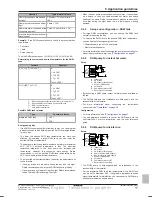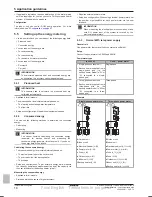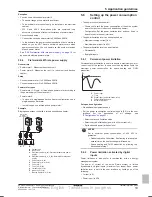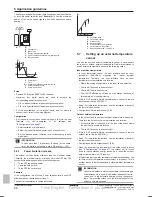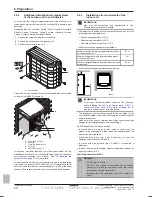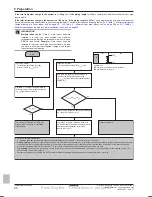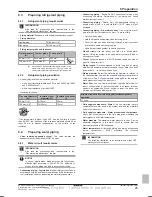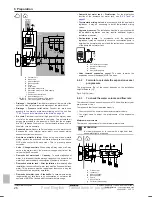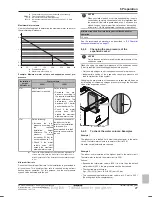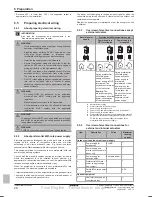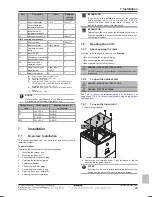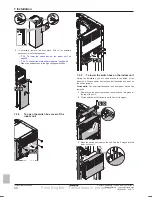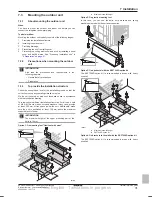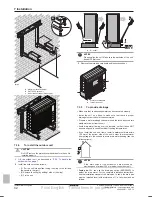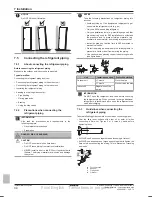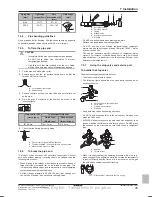
5 Application guidelines
Installer reference guide
20
ERGA04~08DAV3(A) + EHVH/X04+08S18+23DA
Daikin Altherma – Low temperature split
4P495248-1 – 2017.12
The energy management system (field supply) decides the activation
of a certain power limitation level.
Example:
To limit the maximum
power of the entire house (lighting, domestic appliances, space
heating…).
a
b
A
B
C
1
2
3
4
5
A8P
A
Outdoor unit
B
Indoor unit
C
Energy management system
a
Power limitation activation (4 digital inputs)
b
Backup heater
P
i
t
DI4
DI3
DI1
a
b
P
i
Power input
t
Time
DI
Digital inputs (power limitation levels)
a
Power limitation active
b
Actual power input
Setup
▪ Demand PCB (option EKRP1AHTA) needed.
▪ Maximum four digital inputs are used to activate the
corresponding power limitation level:
▪ DI1 = weakest limitation (highest energy consumption)
▪ DI4 = strongest limitation (lowest energy consumption)
▪ For the specifications of the digital inputs, and for where to
connect them, refer to the wiring diagram.
Configuration
▪ Set the power consumption control settings in [9.9] via the user
interface
(for
the
description
of
all
settings,
see
"8 Configuration" on page 47
):
▪ Select limitation by digital inputs.
▪ Select the type of limitation (power in kW or current in A).
▪ Set the desired power limitation level corresponding to each
digital input.
INFORMATION
In case more than 1 digital input is closed (at the same
time), the digital input priority is fixed: DI4 priority>…>DI1.
5.6.3
Power limitation process
The outdoor unit has better efficiency than the electrical heater.
Therefore, the electrical heater is limited and turned OFF first. The
system limits power consumption in the following order:
1
Turns OFF the backup heater.
2
Limits the outdoor unit.
3
Turns OFF the outdoor unit.
Example
If the configuration is as follows: Power limitation level does NOT
allow operation of backup heater (step 1).
Then power consumption is limited as follows:
P
h
C
e
a
b
c
A
B
P
h
Produced heat
C
e
Consumed energy
A
Outdoor unit
B
Backup heater
a
Limited outdoor unit operation
b
Full outdoor unit operation
c
Backup heater step 1 turned ON
5.7
Setting up an external temperature
sensor
You can connect one external temperature sensor. It can measure
the indoor or outdoor ambient temperature. Daikin recommends to
use an external temperature sensor in the following cases:
Indoor ambient temperature
▪ In room thermostat control, the user interface used as room
thermostat
(EKRUDAS)
measures
the
indoor
ambient
temperature. Therefore, the user interface used as room
thermostat must be installed on a location:
▪ Where the average temperature in the room can be detected
▪ That is NOT exposed to direct sunlight
▪ That is NOT near a heat source
▪ That is NOT affected by outside air or air draught because of,
for example, door opening/closing
▪ If this is NOT possible, Daikin recommends to connect a remote
indoor sensor (option KRCS01-1).
▪ Setup: For installation instructions, see the installation manual of
the remote indoor sensor.
▪ Configuration: Select room sensor [9.B].
Outdoor ambient temperature
▪ In the outdoor unit, the outdoor ambient temperature is measured.
Therefore, the outdoor unit must be installed on a location:
▪ At the north side of the house or at the side of the house where
the most heat emitters are located
▪ That is NOT exposed to direct sunlight
▪ If this is NOT possible, Daikin recommends to connect a remote
outdoor sensor (option EKRSCA1).
▪ Setup: For installation instructions, see the installation manual of
the remote outdoor sensor.
▪ Configuration: Select outdoor sensor [9.B].
▪ When the power saving functionality of the outdoor unit is active
(see
"8 Configuration" on page 47
), the outdoor unit is turned
down to reduce standby energy losses. As a result, the outdoor
ambient temperature is NOT read out.
▪ If the desired leaving water temperature is weather dependent, the
full time outdoor temperature measurement is important. This is
another reason to install the optional outdoor ambient temperature
sensor.
INFORMATION
The external outdoor ambient sensor data (either averaged
or instantaneous) is used in the weather-dependent control
curves and in the automatic heating/cooling changeover
logic. To protect the outdoor unit, the internal sensor of the
outdoor unit is always used.
Final English - Tanslations in progress

